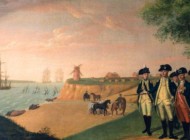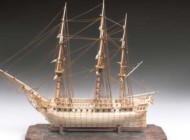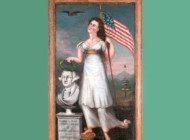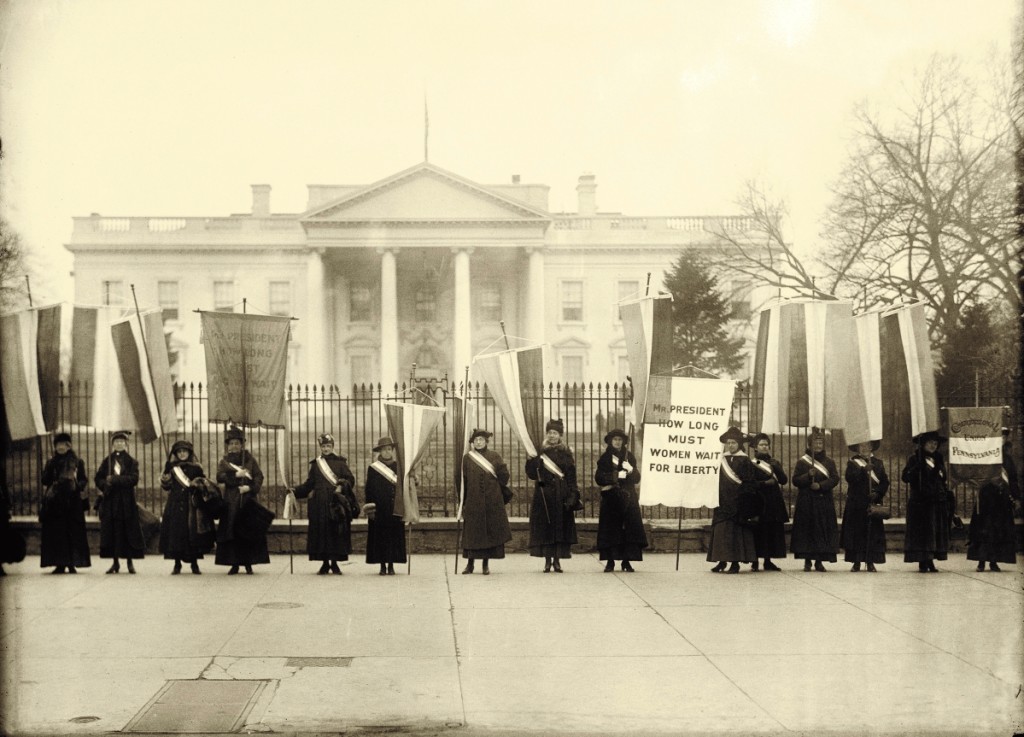
The Silent Sentinels were the first group to demonstrate at this strategic location. Women Suffrage Pickets at the White House, 1917. Harris & Ewing Photograph Collection, Library of Congress.
By Kate Eagen Johnson
CHADDS FORD, PENN. – “My main goal…is to re-create and recapture the look of the suffrage movement,” declared Amanda C. Burdan, curator of the Brandywine River Museum of Art and its current exhibition “Votes for Women: A Visual History.” “It is important for people to understand how crucial the visual campaign and visual messages of the suffrage movement were in finally accomplishing the ratification of the Nineteenth Amendment.”
The year 2020 marks the 100th anniversary of the passage of the Constitutional amendment giving the majority of women in the United States the right to vote. Key among the commemorative exhibitions nationwide is this presentation, incorporating over 200 objects and currently scheduled to be on view until June 7.
In it, Burdan focuses on “the visual language” of the suffrage campaign, particularly during the decade prior to 1920. She provides analysis of the suffrage aesthetic, which was deliberate and carefully managed by leaders, while also decoding the movement’s lexicon of symbols. She draws attention to parades and demonstrations, especially those coordinated by more progressive suffragists, a form of protest “performance art” designed to capture newspaper headlines. Burdan also highlights African Americans’ contributions and perspectives, aspects long neglected.
With the objective of realizing “a full color and well-rounded vision,” the curator augments black and white photographs, cartoons and film with variously hued banners, posters, postcards, stamps, sashes, buttons, garments and other paraphernalia. The pro- and anti-suffrage items showcased include a “Let Mother Vote” button manufactured for the Ohio Women’s Suffrage Association by Whitehead & Hoag Co of Newark, N.J.; a banner emblazoned with the assertion, “Working Women Need the Vote;” a white dress ensemble of the type marching suffragists wore to project dignity and purpose; and a satirical postcard posing the question, “The Suffragette: Should Women ‘Mix’ in Politix?”
On the local, state and national level, suffragists took their crusade to lecture halls, to clubhouses, to government buildings and to the streets. Accented here are the physical manifestations of their advocacy and political action. These include the graphics they produced and distributed, the message-laden artifacts they made or commissioned from companies specializing in political regalia, the parades they oversaw and the high-profile demonstrations they organized in emblematic places. Suffragists capitalized on the power of illustrated newspapers and magazines, the arts of marketing and branding and popular entertainment as an influencer through plays, movies and songs.
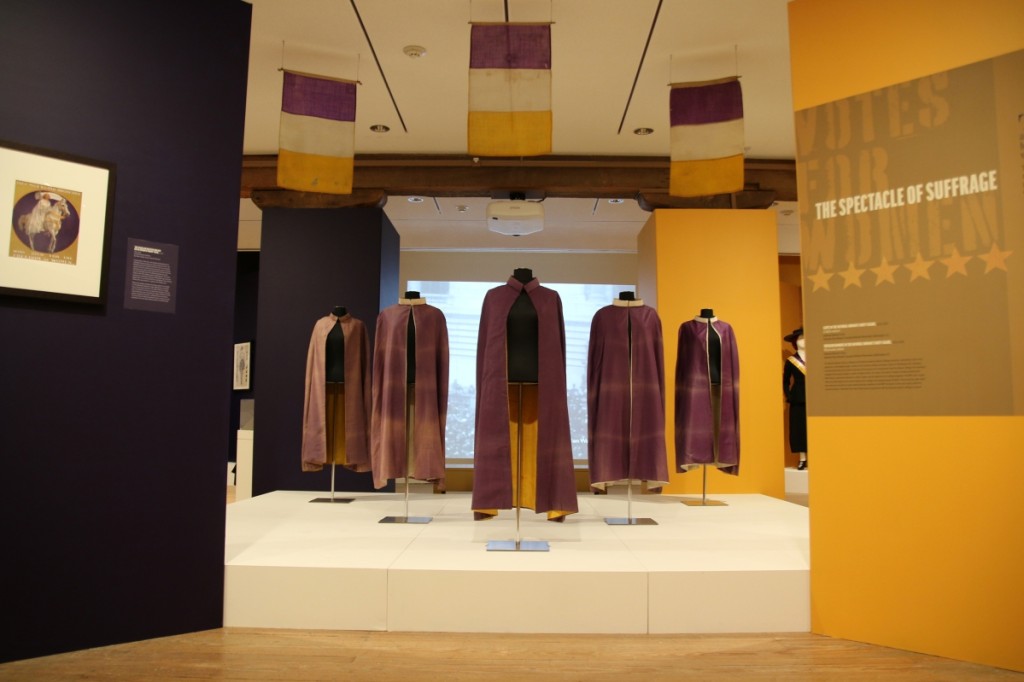
Alice Paul is credited with developing the distinctive suffragist color scheme of purple for loyalty, white for purity and gold for life. She also visually orchestrated the famous 1913 suffragist march in Washington led by lawyer Inez Milholland Boissevain on a white horse. Section of “Votes for Women: A Visual History” featuring marching capes and banners in the National Woman’s Party colors, circa 1913-1920. National Woman’s Party. Belmont-Paul Women’s Equality National Monument, Washington, DC.
Among the boldest and most media-savvy were Alice Paul, Lucy Burns and the younger generation of suffragists who broke away from the National American Women Suffrage Association (NAWSA), forming the Congressional Union for Woman Suffrage, later called the National Woman’s Party (NWP). Typical of their energized, iconoclastic approach was their “Silent Sentinels” protest in front of the White House, the first ever at the presidential mansion. During their demonstration, which began in January 1917 and lasted two years, picketers relied on a somber, steadfast, wordless presence and prominent banners to make their point. Even though their tactics were nonviolent, the women were caught up in a cascade of arrests, jail and workhouse incarceration, guard brutality and hunger strikes before the vigil’s conclusion.
In conversation, Burdan stated that the topic is an unusual one for her institution, with its strong interest in American illustrators and illustration. Fittingly, she entered this new territory through the work of the suffrage champion, artist and cartoonist Nina Allender (1873-1957), who had studied with William Merritt Chase and Robert Henri at the Pennsylvania Academy of Fine Arts and was active with both the NAWSA and the NWP. It was Alice Paul who encouraged Allender to try her hand at political cartooning. In 1914, the artist published her first in the NWP’s weekly, The Suffragist, and soon became its in-house cartoonist. Allender is represented in the exhibition by an issue cover likening the emancipation of women to that of enslaved Africans, ten cartoon drawings, and a reproduction “Jailed for Freedom” pin, the initial version of which she fashioned in 1917. Much like a medal, this piece of jewelry in the form of a cell door with heart-shaped lock was conferred upon women who had been jailed or sent to the workhouse for the cause.
As she began to examine Allender’s cartoons in depth, Burdan was driven to expand the exhibition’s scope. The curator told how she was mystified by some of the iconography, yet people in the 1910s clearly understood it. This breach propelled her to move beyond Allender as the sole subject in favor of “showing the broader visual culture of the period.”
Instructive is Burdan’s discourse on the drawing “American Justice” by Allender in the accompanying exhibition pamphlet. The disturbing cartoon with its ironic title, destined for the cover of a 1918 issue of The Suffragist, shows Uncle Sam presenting flowers to a bound and gagged woman, while exclaiming, “American Women You are our INSPIRATION. You give us our soldiers. You conserve our food. You work in our munition factories. You serve our sick and wounded. ACCEPT this bouquet.” His comments relate to women’s homefront contributions during World War I. Research revealed that the cartoonist was likely making a specific reference to President Woodrow Wilson’s refusal to have a face-to-face discussion with female munitions workers in Delaware seeking equal wages and voting rights. Burdan observed, “Wilson declined to meet with them, instead sending a message that he was ‘doing everything he could do in honor and propriety’ to promote the suffrage amendment. Uncle Sam with his flowers, like Wilson with his words, attempts to appease the woman in distress without changing her situation in a meaningful way.”
“President Abraham Lincoln with a Former Slave” by Charlotte “Lottie” Wilson (1854-1914) is another work whose full symbolism is not immediately apparent. Wilson, the first African-American student to attend the Art Institute of Chicago, was committed to the women’s suffrage cause. Terming the painting “a real discovery,” Burdan remarked that while viewers might assume that the depiction of Lincoln and “the former slave” Sojourner Truth was made soon after their 1864 White House meeting, and therefore a product of the abolitionist era, it actually dates from 1902. She explained the picture’s complicated backstory. Wilson created this canvas based on a photograph of a similar painting by Franklin C. Courter that was well known through its display at the 1893 Chicago Columbian Exposition but then destroyed in a fire. Notably, Wilson’s version was exhibited at the White House in 1902 during Theodore Roosevelt’s occupancy.
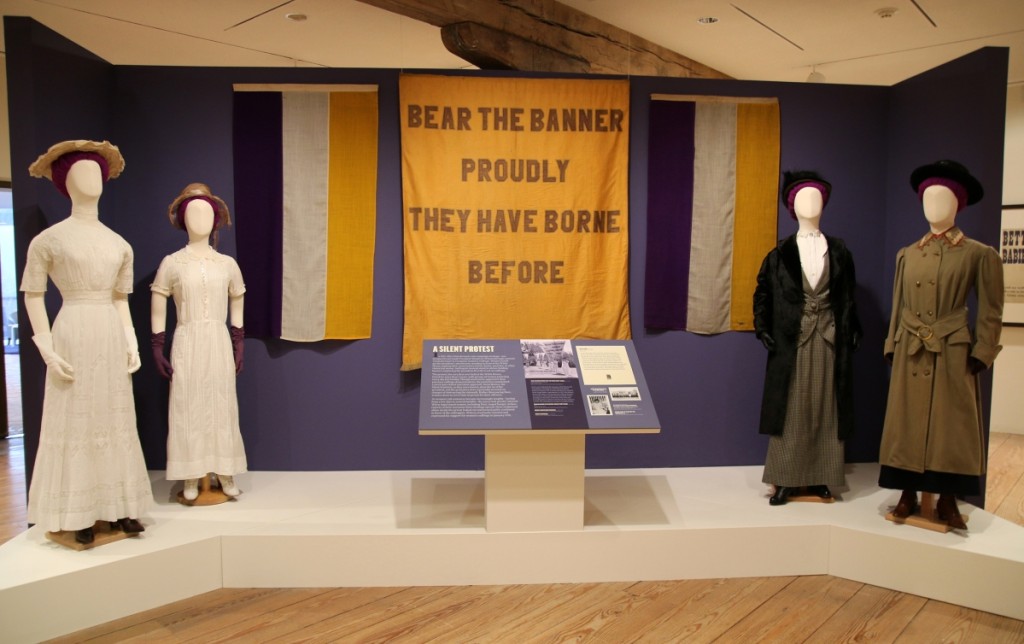
Exhibition vignette with the “Bear the Banner Proudly They Have Borne Before” banner, circa 1913-1920. National Woman’s Party. Belmont-Paul Women’s Equality National Monument, Washington, DC.
The curator discovered yet one more double portrait of “the Great Emancipator” and Sojourner Truth, who fought for the rights of women as well as for those of African Americans. This illustration graced the cover of a special “Votes for Women” edition of Crisis, the NAACP’s magazine, published in August 1915. Burdan came to appreciate that much women’s suffrage imagery aimed at African Americans drew upon abolition-related visuals, even to the use of “Lincoln’s Log Cabin.” She summarized, “African-American suffrage material goes unnoticed because it looks like abolitionist material.”
Burdan went on to address the widely held misconception that since white suffrage organizations largely closed their doors to black members, African Americans did not participate in the movement, a fallacy she seeks to rectify. “On both sides of the coin, I think historians of mainstream culture have led us to believe that African Americans, and women of color in general, were not involved. And then, at the same time, our institutions – whether they are museums, historical societies, libraries or colleges – have not really collected or institutionalized the histories of women of color. It’s a self-fulfilling prophecy. One group tells us they aren’t there and the evidence seems to be, ‘They weren’t there.’ You just have to scratch the surface a bit.”
Following in this vein, the Brandywine River Museum of Art has commissioned a mural entitled “Hidden Figures of the Suffrage Movement” spotlighting 14 underappreciated torchbearers. Aside from the aforementioned Charlotte Wilson, those honored include journalist and anti-lynching proponent Ida B. Wells (1862-1931), Turtle Mountain Chippewa attorney and activist Marie Louise Bottineau Baldwin (1863-1952), Texas-born journalist and education advocate Jovita Idár (1885-1946) and economist and women’s rights proponent Mabel Ping-Hua Lee (1896-1966). The mural is the work of artists Alexandra Beguez, Laura Freeman, Sarah Jung, Shadra Strickland and Sally Wern Comport.
By focusing on deeds and imagery over speech scripts and manifestos in her suffrage study, Burdan is to be commended for taking the road less traveled.
For more information on other women’s suffrage exhibitions, see 2020centennial.org/exhibits-2.
The Brandywine River Museum of Art is temporarily closed in response to the Coronavirus. It is at 1 Hoffman’s Mill Road. For more information, 610-388-2700 or brandywine.org.














